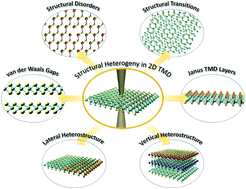Atomic-scale characterization of structural heterogeny in 2D TMD layers
Abstract
The heterogeneity features in 2-dimensional (2D) transition metal dichalcogenide (TMD) layered materials endow them with distinctive properties for a vast array of novel applications. Their unique properties stem from the various aspects of atomic displacements of in-plane and cross-boundary interfacial defects. Understanding and gaining insights into the formation and evolution of these structural defects and heterogeneities provide rich information for tailoring the properties of the corresponding materials and devices as well as future designs of new heterostructures and heterointerfaces. Transmission electron microscopy (TEM) is a widely-adopted characterization technique for the direct visualization of atomic defects across a plethora of 2D TMD surfaces and interfaces. The present review aims to summarize the atomic scale TEM characterization of heterogeny in 2D TMD layers, featuring structural and chemical disorders and heterointerfaces in 2D TMD layers, as well as the in situ observation of the transition and evolution of defects and interfaces via TEM in addition to the generation and manipulation of defects and heterointerfaces.

- This article is part of the themed collections: Recent Review Articles, Popular Advances and Advances in Materials Characterisation


 Please wait while we load your content...
Please wait while we load your content...